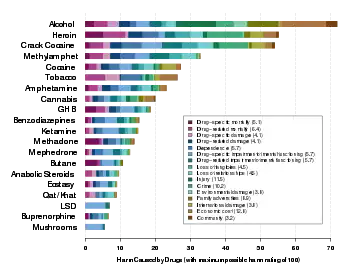Hallucinogen persisting perception disorder
Hallucinogen persisting perception disorder (HPPD) is a chronic disorder in which a person has non-psychotic flashbacks of visual hallucinations or distortions experienced during a previous hallucinogenic drug experience, usually lacking the same feelings of mental intoxication experienced before. Hallucinations are usually not intense or impairing and consist of visual snow, trails and after images (palinopsia), light fractals on flat surfaces, intensified colors or other psychedelic visuals. To be diagnosed, the disorder must cause distress or impairment in work or everyday life.[1] The flashbacks may be continuous or just occasional.[1] Symptoms often get worse when focused on.
| Hallucinogen persisting perception disorder | |
|---|---|
 | |
| HPPD noise simulation, often referred to as visual snow | |
| Specialty | Psychiatry |
History
In 1898, the English writer and intellectual Havelock Ellis reported a heightened sensitivity to "the more delicate phenomena of light and shade and colour" for a prolonged period of time after consuming the psychedelic drug mescaline. This may have been one of the first recorded cases of what would later be known as HPPD.[2]
HPPD subtypes
According to a 2016 review, there are two theorized subtypes of the condition.[3] Type 1 HPPD is where people experience HPPD in the form of random, brief flashbacks. In addition, Type 2 HPPD is where people experience ongoing changes to their vision, which may vary in intensity.
Cause
HPPD is not related to psychosis due to the fact those affected by the disorder can easily distinguish their visual disturbances from reality. [4] The only certain cause of HPPD is prior use of hallucinogens. Some evidence points to phenethylamines carrying a slightly greater risk than lysergamides or tryptamines. There are no known risk factors, and what might trigger any specific disturbing hallucination is not known.[1] Some sort of disinhibition of visual processing may be involved.[5] It has been suggested MDMA (ecstasy) use with other drugs is linked to the development of HPPD.[6]
Diagnosis
HPPD is a DSM-5 diagnosis with diagnostic code 292.89 (F16.983).[1] For the diagnosis to be made, other psychological, psychiatric, or neurological conditions must be ruled out and it must cause distress in everyday life.[1]
Treatment
As of 2021 there is still no good evidence of any specific medicinal treatment as being commonly effective for HPPD. Some reports point to sedatives being helpful and stimulants and cannabis worsening symptoms.
Avoiding any additional use of psychoactive drugs (including cannabis and alcohol) from an early stage of the disorder seems to be an effective way for many sufferers to achieve recovery, as these substances apparently worsen the condition over time.
Some prescription drugs (Lamictal, clonazepam, keppra and others) have been known to relieve symptoms for some, but worsen symptoms or create dependencies for others.
Antipsychotic drugs and SSRIs have also been reported to help some people temporarily but worsen symptoms for others.
Some sufferers have reported benefits from prolonged water fasting, medications like NAC and Lithium, and from supplements like L-Tyrosine, Ashwagandha and lion's mane, although some users report lion's mane and Ashwagandha as having potentially negative effects or creating dependencies.
Sunglasses and talk therapy might also help those who are dealing HPPD, but in general it seems that maintaining sobriety from all psychoactive substances is still the best solution available for this condition, as it's been proven to naturally relieve the disorder over time.
Prevalence
The prevalence of HPPD was unknown as of 2018. Estimates in the 1960s and 1970s were around 1 in 20 for intermittent HPPD among regular users of hallucinogens. It is not clear how common chronic HPPD may be, but one estimate in the 1990s was that 1 in 50,000 regular users might have chronic hallucinations.[1]
Society and culture
In the second episode of the first season of the 2014 series True Detective ("Seeing Things"), primary character Rustin Cohle (Matthew McConaughey) is depicted as having symptoms similar to HPPD such as light tracers as a result of "neurological damage" from substance use.[7]
American journalist Andrew Callaghan, the host of the internet series All Gas No Brakes, revealed during a 2021 interview with Vice News that he has a HPPD diagnosis as a result of excessive psilocybin use at a young age. Describing his symptoms, he noted that he experiences persistent visual snow and palinopsia.[8]
References
- Halpern, JH; Lerner, AG; Passie, T (2018). "A Review of Hallucinogen Persisting Perception Disorder (HPPD) and an Exploratory Study of Subjects Claiming Symptoms of HPPD". Current Topics in Behavioral Neurosciences. 36: 333–360. doi:10.1007/7854_2016_457. ISBN 978-3-662-55878-2. PMID 27822679.
- https://dana.org/article/when-the-trip-never-ends/
- Halpern, John H.; Lerner, Arturo G.; Passie, Torsten (2016). "A Review of Hallucinogen Persisting Perception Disorder (HPPD) and an Exploratory Study of Subjects Claiming Symptoms of HPPD". Behavioral Neurobiology of Psychedelic Drugs. Current Topics in Behavioral Neurosciences. 36. pp. 333–360. doi:10.1007/7854_2016_457. ISBN 978-3-662-55878-2. PMID 27822679.
- Bogenshutz, M.P ., & Ross, S. (2018). "Therapeutic Applications of Classic Hallucinogens". Current Topics in Behavioral Neuroscience.CS1 maint: multiple names: authors list (link)
- G Lerner, A; Rudinski, D; Bor, O; Goodman, C (2014). "Flashbacks and HPPD: A Clinical-oriented Concise Review". The Israel Journal of Psychiatry and Related Sciences. 51 (4): 296–301. PMID 25841228.

- Litjens, Ruud P. W.; Brunt, Tibor M.; Alderliefste, Gerard-Jan; Westerink, Remco H. S. (August 2014). "Hallucinogen persisting perception disorder and the serotonergic system: a comprehensive review including new MDMA-related clinical cases". European Neuropsychopharmacology. 24 (8): 1309–1323. doi:10.1016/j.euroneuro.2014.05.008. ISSN 1873-7862. PMID 24933532.
- Fukunaga, Cary Joji, 1977- Cuddy, Carol. Pizzolatto, Nic, 1975- McConaughey, Matthew, 1969- Harrelson, Woody. Monaghan, Michelle. Potts, Michael (Performer) Arkapaw, Adam. Hall, Alex (Film editor) Burnett, T-Bone., True detective., OCLC 964500128CS1 maint: multiple names: authors list (link)
- Documenting America's Underbelly - ALL GAS NO BRAKES (video). Vice. January 21, 2021. 20:48-21:49 minutes in. Retrieved January 24, 2021.
External links
| Classification | |
|---|---|
| External resources |
